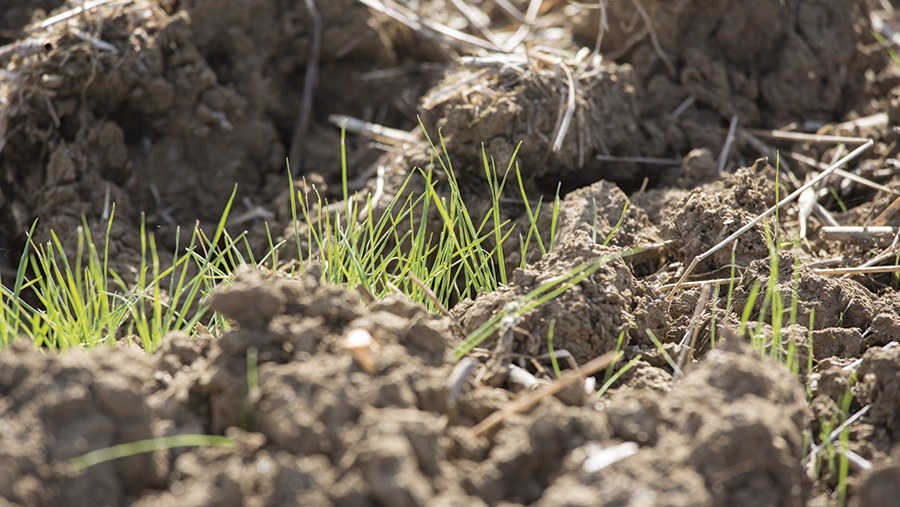Crop Watch: Patience rewarded as soil moisture spurs on grassweed chit
 © TIm Scrivener
© TIm Scrivener A rumbling of grassweed and pest activity features as a major talking point among our Crop Watch agronomists this week.
Grassweed emergence is now firmly into its stride and Marion Self says growers’ patience will be rewarded if nerves of steel have triumphed over the itch to drill early into good conditions.
Antony Wade notes that virus-carrying aphids are not hard to spot in cereal volunteers and suspects even seed-treated crops may need a follow up insecticide spray.
In the North, Mary Munro says growers and agronomists need to be looking out for blackgrass as arable’s most troublesome weed creeps into Scotland.
Richard Harding says good soil moisture levels should help the control of pre-emergence herbicide stacks.
See also: Map: Mild autumn sparks oilseed rape phoma fears
East: Marion Self
 Prime Agriculture (Suffolk)
Prime Agriculture (Suffolk)
A dry September and early October has allowed a spread of drilling dates. Those waiting for grassweeds to germinate in stale seed-beds should be rewarded as blackgrass is now flushing.
If the weather forecast allows these growers to hold their nerve another week or two their patience should be rewarded.
While it’s preferable to apply the pre-emergence herbicides in moist conditions, growers are encouraged to apply these treatments before the blackgrass emerges.
In “difficult” blackgrass situations crops are receiving large herbicide stacks and sequences based on a keystone of flufenacet with the addition of other actives according to herbicide resistance status and previous performance.
To maximise the performance and crop safety of these mixes, ensure the seed is well covered and seed-beds are as good as conditions allow.
Aphids vectors of barley yellows dwarf virus (BYDV), mainly the bird-cherry aphid, continue to migrate.
Most first wheats after rapeseed and winter barley are routinely treated with Deter (clothianidin) and will be protected for approximately six to eight weeks after drilling.
Non-Deter treated crops will need protection at the second leaf stage with pyrethroid, a follow up treatment will be required.
Slugs activity is moderate in drier soils but be vigilant and monitor crops. There is an army of slugs underground ready to deploy as soils become wetter.
As conditions become cooler and wet the ferric phosphate based pellets will become the best choice with more activity and being safer to the environment than metaldehyde.
The better oilseed rape crops now at full establishment are getting robust enough for winter and growing away from pest damage.
Aphid monitoring shows those which transmit the turnip yellows virus are now migrating into crops.
These aphids are widely resistant to carbamates such as pirimicarb and/or pyrethroids such as lambda-cyhalothrin, so treatment with another mode of action is recommended with Plenum (pyridine) or a neonicitinoid such as Biscaya.
Some crops will require early grassweed control with either clethodim or carbetamide depending on the situation.
West: Antony Wade
 AICC (Hereford/Shropshire)
AICC (Hereford/Shropshire)
Harvest seems a long time ago now, but as I sat down to key my first report of the season it was worth a moment of reflection.
It struck me that cereal performance mirrored some of the UK team sport performance over the summer.
Winter barley, after showing early promise fuelling us with optimism, woefully failed to produce any quality or output in the final stages of the season; akin to the England football team.
Winter wheat performed strongly but wasn’t outstanding with a few highs and less lows; like the English cricket team.
However, the increasing incidence of blackgrass, not to mention bromes and resistant ryegrass, show the challenges will only get harder.
We are in the middle of maize harvest and I have heard of some big hauls, so maybe these will be of Olympian magnitude or maybe my sporting summer analogies just fall down at this point.
Unlike parts of the East, we have had enough moisture so oilseed rape emerged well.
Apart from a few flea beetle hotspots, slugs have been more of the concern with some crop losses.
Where we have got through the early slug challenge there are already some crops where a fungicide with plant growth regulator activity is being considered as the first input.
Soil moisture, while being a blessing for crop emergence, brings with it the challenge of significant levels of ryegrass and blackgrass emerging, so clethodim and/or carbetamide herbicides will be deployed where required.
First wheats have gone into good seed-beds and emerged well generally.
Increasing grassweed problems require increased residual herbicide stacks which are more consistent than relying on contact herbicides.
With winter barley there’s even more importance of pre-emergence herbicide for grassweed control with the reduced contact herbicide portfolio.
Aphids are easily found on volunteer cereals, so unless we have some early frosts insecticides will be need to be deployed, even where seed treatments were used.
North: Mary Munro
 AICC/Strutt & Parker (Perthshire)
AICC/Strutt & Parker (Perthshire)
We have enjoyed a real Indian summer recently and although temperatures are cold at night, the good spell of weather has enabled fields to be cleared, worked, sown and sprayed without too much stress.
It feels unseasonable but I wrote much the same last October.
Even beans that looked like they would not be ready until November have been harvested. Potato producers might like some rain for lifting the remaining crop but otherwise there are few complaints about soil conditions.
There are plenty of other challenges though. Grain prices are projected to stay low due to large world stocks, and only the weak pound is keeping the job sensible.
We prepare a lot of budgets at this time of year and they do not make for very inspiring reading – the income from a reasonable yield at modest prices has a lot of costs to cover.
If there is excessive expenditure on the variable costs then the margin is less, and the fixed costs can quickly swallow up the remainder.
There are usually areas where savings can be made or efficiency increased – sometimes it takes a fresh pair of eyes to see them and then the resolve to make it happen.
For most arable farmers in Scotland the BPS is on a downward slide to 2019-20 and changes are required if the gap in income is to be filled.
We are fortunate that blackgrass is not a major problem north of the Border, but each year more farms are finding it as it creeps inexorably north in machinery and, it would now appear, seed stock.
This is a huge concern for us and agronomists have to be vigilant when walking crops, but farmers should also think about the practicalities of ensuring that machinery coming on to the farm is clean and take precautions to prevent blackgrass seed reaching the soil in the first place.
South: Richard Harding
 ProCam (Sussex)
ProCam (Sussex)
Here on the Downs good conditions have seen the drills out in force this week and overall cereals are being drilled into very good seed-beds.
Recent rains have been enough to encourage a level of blackgrass to grow and pre-emergence herbicides based around flufenacet, diflufenican, flutamone and prosulfocarb do have a bit of moisture in the soil to aid their activity.
On the lightest land with limited grassweed pressure where it is considered just too dry for a pre-emergence herbicide, we will be wait for moisture before spraying.
This delayed timing may well allow for inclusion of an autumn aphicide. After last season’s barley yellow dwarf virus (BYDV) levels, mainly due to the very mild autumn and winter there, will be no room for complacency.
Overall, there are some very good crops of oilseed rape, I have a few fields that have suffered poor establishment but due to earlier lack of moisture rather than cabbage stem flea beetle.
However, a little further east and into Kent, the lack of moisture has been a real issue for some crops.
Oilseed rape crops that have got going are now showing the familiar white blotches from leaf miner but are growing away from this damage.
Clethodim is being applied where blackgrass is a problem and to tidy up any remaining cereal volunteers.
Where slugs are a problem the preference is to use ferric phosphate to help protect water catchment areas.
Rapeseed crops are also now being monitored for phoma in combination with the new forecast tool from Rothamsted which uses weather data to predict when it is expected 10% of plants will show symptoms.
This is generally regarded as the threshold when considering the need for a fungicide application.
On forward crops requiring some growth regulatory action tebuconazole alone or in mixture with difenconazole will be the actives of choice.

